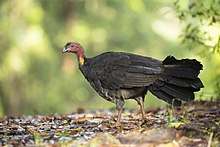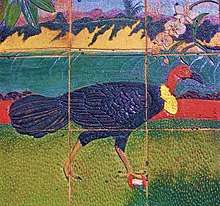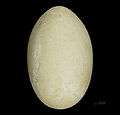Australian brushturkey
The Australian brushturkey or Australian brush-turkey or gweela (Alectura lathami), also frequently called the scrub turkey or bush turkey, is a common, widespread species of mound-building bird from the family Megapodiidae found in eastern Australia from Far North Queensland to Eurobodalla on the south coast of New South Wales. The Australian brushturkey has also been introduced to Kangaroo Island in South Australia. It is the largest extant representative of the family Megapodiidae, and is one of three species to inhabit Australia.
| Australian brushturkey | |
|---|---|
 | |
| Cairns, Queensland, Australia | |
| Scientific classification | |
| Kingdom: | Animalia |
| Phylum: | Chordata |
| Class: | Aves |
| Order: | Galliformes |
| Family: | Megapodiidae |
| Genus: | Alectura Latham, 1824 |
| Species: | A. lathami |
| Binomial name | |
| Alectura lathami Gray, 1831 | |
| Subspecies | |
| |
Despite its name and their superficial similarities, the bird is not closely related to American turkeys, nor to the Australian bustard, which is also known as the bush turkey. Its closest relatives are the wattled brushturkey, Waigeo brushturkey, and malleefowl.
Biology
It is a large bird with black feathers and a red head. Its total length is about 60–75 cm (23.5–29.5 in) and a wingspan of about 85 cm (33 in). The subspecies A. l. purpureicollis from the northern Cape York Peninsula is smaller than the more widespread nominate subspecies. It has a prominent, fan-like tail flattened sideways, and its plumage is mainly blackish, but with a bare red head, and a yellow (in the nominate subspecies) or purple wattle (in A. l. purpureicollis). The males' wattles become much larger during breeding season, often swinging from side to side as they run. The males' heads and wattles also become much brighter during the breeding and nesting season. The underside of the body is sprinkled with white feathers, more pronounced in older birds. The brushturkey is a clumsy flyer and cannot fly long distances, only taking to the air when threatened by predators or to roost in trees at night and during the heat of the day.
.jpg)
They build large nests on the ground made of leaves, other compostable material, and earth, 1 to 1.5 metres (3.3 to 4.9 ft) high and up to 4 m (13 ft) across. Mound-building is done by a dominant male, and visited by a succession of local females, for mating and egg-laying. The male works tirelessly, collecting material from all around, and also diligently repelling rival males, which are keen to usurp his position. The effort involved eventually wears him down, and he will ultimately be defeated by a new king. The eggs are very large (90 × 45 mm), and the young are fully fledged on hatching. They can fly within hours, as soon as the feathers are dry. The eggs are hatched by the heat of the composting mound, the temperature of which is regulated by adding or removing material to maintain the temperature in the 33–35 °C (91–95 °F) incubation temperature range.[2] The Australian brushturkey checks the temperature by sticking its beak into the mound. Like some reptiles, incubation temperature affects the sex ratio of chicks, but the mechanism is different between reptiles and these birds, with reptiles exhibiting temperature-dependent sex determination, and megapodes exhibiting temperature-dependent embryo mortality. The sex ratio in brushturkeys is equal at incubation temperatures of 34°C, but results in more males when cooler and more females when warmer (p=0.035). Whether the parents use this to manipulate the sex of their offspring by, for instance, selecting the nesting site accordingly, is unclear. Warmer incubation also results in heavier, fitter chicks (p<0.0001), but how this is linked to gender is also unknown.[3]
The same nesting site is frequently used year after year, with the old nests being added to each breeding season. The average clutch of eggs is between 16 and 24 large white eggs, which are laid September to March. Sometimes, up to 50 eggs laid by several females may be found in a single mound. The eggs are placed in a circle roughly 60–80 cm (23.5–31.5 in) down, 20–30 cm (8–12 in) apart, always with the large end up. The newly hatched young dig themselves out of the mound and then have to care for themselves.
Brushturkey eggs are a favourite food of goannas, snakes, and dingoes and dogs, though brushturkeys were also a staple of Aboriginal Australians. Often, goannas exhibit wounds on their tails from having been pecked by brushturkeys that ferociously chase them away from their nests.
In situations where they come into contact with humans, such as picnic areas in national parks and suburban gardens, brushturkeys exhibit little fear and often boldly attempt to steal food from tables and raid compost bins. They nest in suburban gardens, and in search of material for their nests remove enormous amounts of mulch from gardens.
Habitat
The Australian brushturkey inhabits rainforests and wet sclerophyll forests, but can also be found in drier scrubs and open areas. In the northern part of its range, the Australian brushturkey is most common at higher altitudes, but individuals move to the lowland areas in winter. In the south, it is common in both mountain and lowland regions.
Brushturkeys are now common in urban environments and can be found in backyards in both Brisbane and Sydney.[4][5]
Population
Brushturkeys are fairly common presently, but in the 1930s, the bird was supposed to be approaching extinction.[6]
Feeding
Brushturkeys feed upon insects, seeds, and fallen fruits, which are exposed by raking the leaf litter or breaking open rotten logs with their large feet. The majority of food is obtained from the ground, with birds occasionally observed feeding on ripening fruits among tree branches.
Human interaction

The Australian brushturkey can damage gardens when raking up the ground looking for food.[7] It can also cause extensive damage to food crops.[8] The Department of Environment, Climate Change, and Water provides hints for living with brushturkeys in urban environments.[4]
They are sometimes hunted for food, including as part of the diet by traditional Aboriginal Australians.[7][9][10] Their eggs, which weigh on average 180 g (6.3 oz), are also sometimes eaten.[11]
The Australian brush-turkey is fully protected in Queensland.[12] Management of its natural habitat and respect for the bird is important if the brush-turkey is to continue to have a secure future. Under the Nature Conservation Act 1992, it is an offence to harm brush turkeys. For a class 1 offence it is 3000 penalty units or 2 years imprisonment. For a class 4 offence it is 100 penalty units or $13,345.00 Au.
In New South Wales, shooting a brush turkey has resulted in fines of up to $22,000 under the Biodiversity Conservation Act.
References
- BirdLife International (2012). "Alectura lathami". IUCN Red List of Threatened Species. 2012. Retrieved 26 November 2013.CS1 maint: ref=harv (link)
- "Australian Brushturkey". NSW Department of Planning, Industry and Environment. New South Wales Government.
- Göth, Ann; Booth, David T (22 March 2005). "Temperature-dependent sex ratio in a bird". Biology Letters. 1: 31–33. doi:10.1098/rsbl.2004.0247. PMC 1629050. PMID 17148121.
- "Living with Brush Turkeys" (Press release). New South Wales Government. 27 April 2009. Archived from the original on 8 April 2013. Retrieved 10 February 2013.
- Taylor, John (29 December 2014). "Brisbane's brush turkey explosion heads south". ABC. Retrieved 1 June 2016.
- "Outdoor Australia". The Sydney Mail. 8 January 1930. p. 19.
- Sarah Collerton (17 August 2009). "Man v bird: the brush turkey battle". ABC News. Archived from the original on 25 August 2012. Retrieved 8 April 2013.
- Brian Williams (5 April 2013). "Stuff the turkeys, dingoes need a break". The Courier Mail. Retrieved 8 April 2013.
- Melinda James (presenter) (23 April 2010). "A bush tucker hunting program helps homeless men re-connect with traditional culture". Stateline NT. ABC Katherine. Archived from the original on 8 April 2013. Retrieved 8 April 2013.
- Louise FitzRoy; Gavin Cahill (18 August 2008). "Bush tucker first up on the Cold Esky Challenge". ABC Rural. Retrieved 8 April 2013.
- "Fact Sheet — Bush Tucker" (PDF). Australia's Tropical Rainforest World Heritage. Wet Tropics Management Authority. Archived (PDF) from the original on 11 May 2013. Retrieved 8 April 2013.
- "Australian brush-turkey". Environment. The State of Queensland (Department of Environment and Science). 23 June 2003. Retrieved 6 April 2020.
- Edden, R. and Boles, W.E. 1986. Birds of the Australian Rainforests. Reed Books, Sydney.
- Marchant, S. and Higgins, P.J. (eds) 1993. Handbook of Australian New Zealand And Antarctic Birds Vol. 2: (Raptors To Lapwings). Oxford University Press, Melbourne.
- Olsen, P., Crome, F. and Olsen, J. 1993. The Birds of Prey and Ground Birds of Australia. Angus and Robertson, and the National Photographic Index of Australian Wildlife, Sydney.
Gallery
 Male Australian brushturkey at Mount Coot-tha, Queensland
Male Australian brushturkey at Mount Coot-tha, Queensland Female Australian brushturkey
Female Australian brushturkey- Australian brushturkey (front view)
 Australian brushturkey chick
Australian brushturkey chick- Standing on a wooden bench in a public picnic area
 Male, A. l. lathami
Male, A. l. lathami- Australian brushturkey portrait, taken while feeding
 Egg of Alectura lathami (Muséum de Toulouse)
Egg of Alectura lathami (Muséum de Toulouse)
External links
- Australian Brush-turkey videos, photos & sounds on the Internet Bird Collection
- Deterring brush turkeys - New South Wales Government
- Factsheets — Brushturkey
